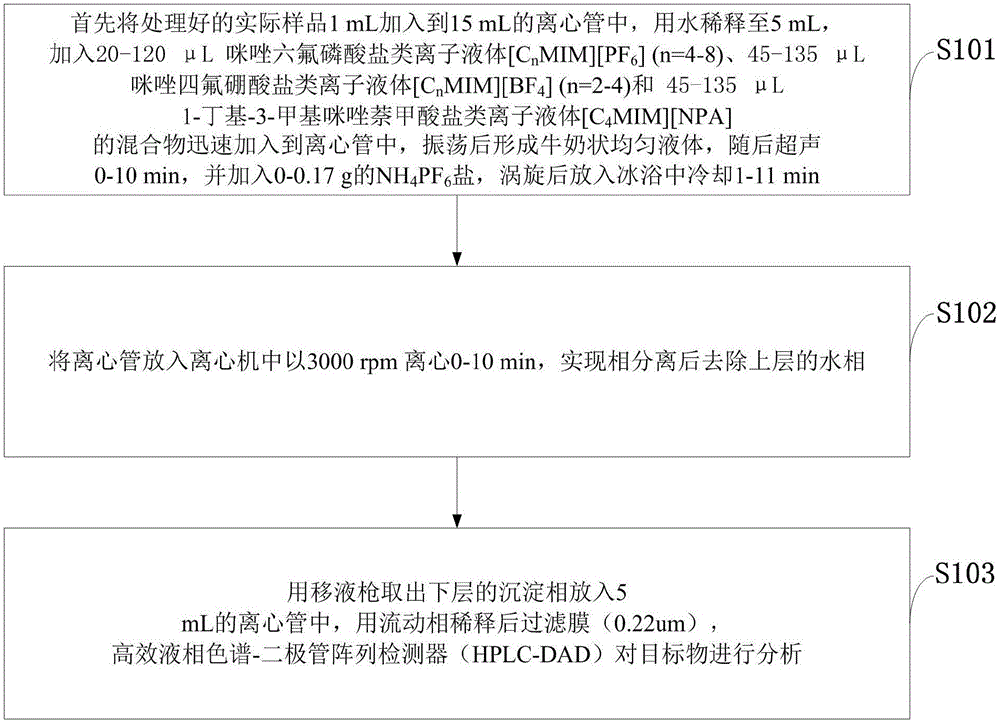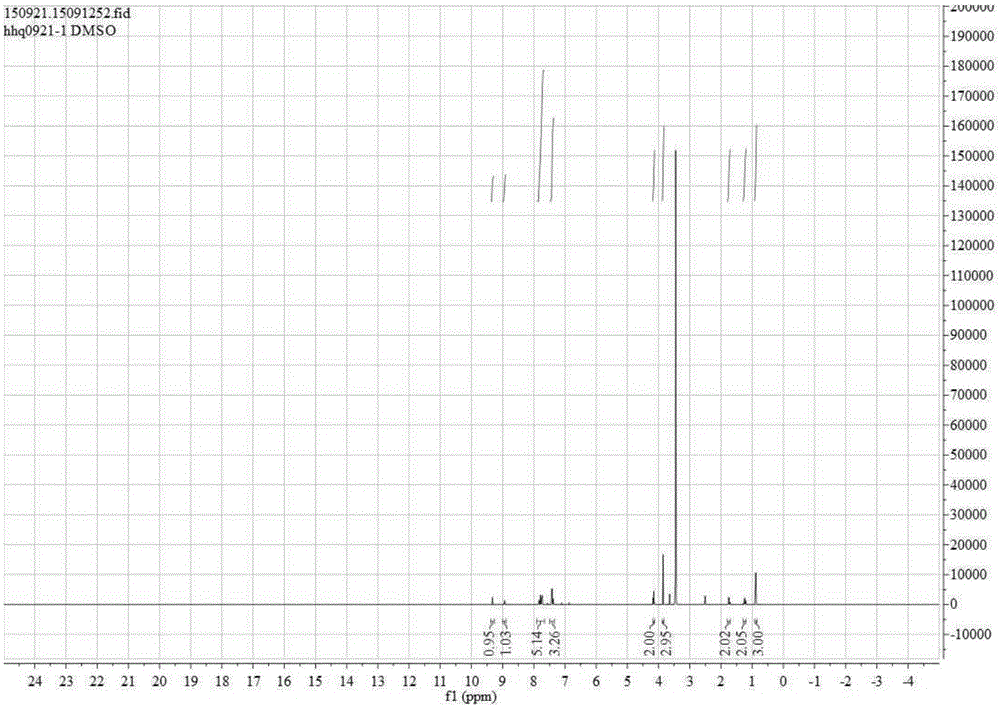Microextraction method for detecting triclosan and methyl triclosan
An extraction and methyl imidium technology, which is applied in the field of fungicide detection, can solve the problems of long time consumption, high cost, and environmental protection, and achieve the effects of simple operation, mature synthesis conditions, and improved recovery rate
- Summary
- Abstract
- Description
- Claims
- Application Information
AI Technical Summary
Problems solved by technology
Method used
Image
Examples
Embodiment 1
[0044] Embodiment 1: [C 4 Synthesis of MIM][NPA]
[0045] Step 1: Weigh 4g (48.7mmol) of N-methylimidazole into a single-necked flask, and then weigh 6.68g (72.2mmol) of 1-chloromethane (about 1.1 to 1.5 times the molar amount of N-methylimidazole) , slowly drop into a single-necked flask, after the dropwise addition, reflux reaction at 80°C for 24h, monitor the reaction by thin-layer chromatography, after the reaction is complete, cool the liquid in the system, evaporate excess 1-chloromethane to obtain a white solid , the yield was 90%. Step 2: Weigh 1.8g NaOH (45mmol) in a beaker (slightly excess NaOH), dissolve it with a very small amount of water, then weigh 7.53g (43.8mmol) of 1-naphthoic acid in a single-necked flask, add the completely dissolved NaOH In the system, react at 80°C for 24 hours to obtain a yellow solution, which is monitored by pointing a plate. After the reaction is completed, part of the water is evaporated, and the remaining solution is used for the ...
Embodiment 2
[0046] Embodiment 2: the detection of TCS and MTCS in the blood sample
[0047] Blood pre-treatment: Add 1mL healthy volunteer serum to a 10mL centrifuge tube, then add 4mL acetonitrile to shake for 2min, then place in a water bath at 85°C for 15min, cool and centrifuge at 5000rpm for 15min, and filter the supernatant after centrifugation (0.45 μm filter membrane), centrifuged at 10000 rpm for 5 min, and the supernatant was taken as the actual sample. Follow-up "all ionic liquid microextraction" operating procedures are as follows image 3 .
[0048] HPLC detection conditions: the mobile phase is acetonitrile (A), methanol (B) and ultrapure water (C) at a flow rate of 1.5 mL / min for binary gradient elution. The gradient elution program was as follows: 0 min, 75% acetonitrile; 3 min, 65% acetonitrile; 5 min, 50% acetonitrile; 7 min, 80% acetonitrile and 8-14 min, 70% acetonitrile, with a total run time of 8 min. The injection volume was 20 μL, the detection wavelength was 28...
Embodiment 3
[0049] Example 3: TCS and MTCS detection in urine samples
[0050] Urine pre-treatment: Add 3mL of healthy volunteer urine into a 10mL centrifuge tube, then centrifuge at 4000rpm for 10min, then filter the supernatant (0.22μm filter membrane), and take the supernatant as the actual processed sample.
[0051] HPLC detection conditions: the mobile phase is acetonitrile (A), methanol (B) and ultrapure water (C) at a flow rate of 1.5 mL / min for binary gradient elution. The gradient elution program was as follows: 0 min, 75% acetonitrile; 3 min, 65% acetonitrile; 5 min, 50% acetonitrile; 7 min 80% acetonitrile and 8-14 min 70% acetonitrile. The total run time was 8 min. The injection volume was 20 μL, the detection wavelength was 280 nm, the column temperature was 30° C., and the injection volume was 20 μL. Chromatographic peaks of TCS and MTCS in urine samples Figure 4 .
PUM
 Login to View More
Login to View More Abstract
Description
Claims
Application Information
 Login to View More
Login to View More - R&D
- Intellectual Property
- Life Sciences
- Materials
- Tech Scout
- Unparalleled Data Quality
- Higher Quality Content
- 60% Fewer Hallucinations
Browse by: Latest US Patents, China's latest patents, Technical Efficacy Thesaurus, Application Domain, Technology Topic, Popular Technical Reports.
© 2025 PatSnap. All rights reserved.Legal|Privacy policy|Modern Slavery Act Transparency Statement|Sitemap|About US| Contact US: help@patsnap.com



